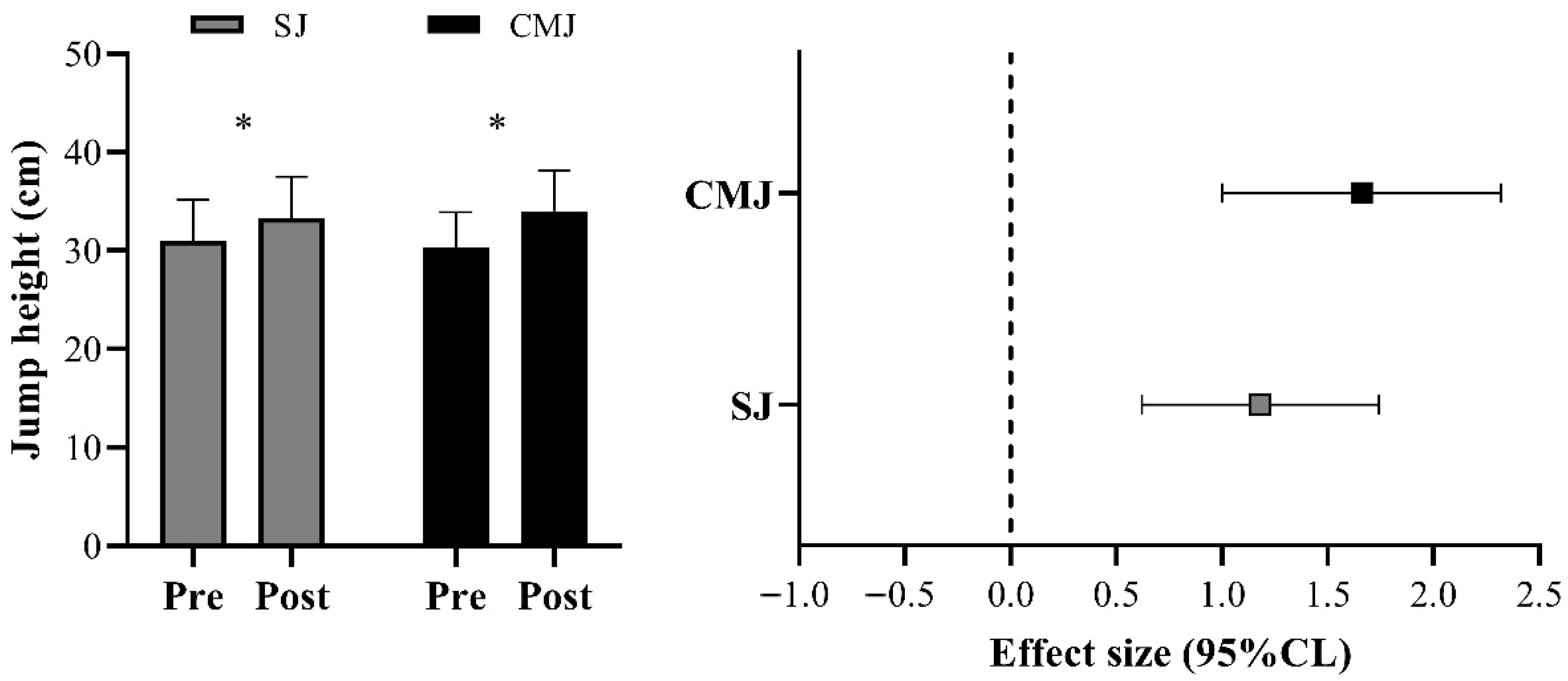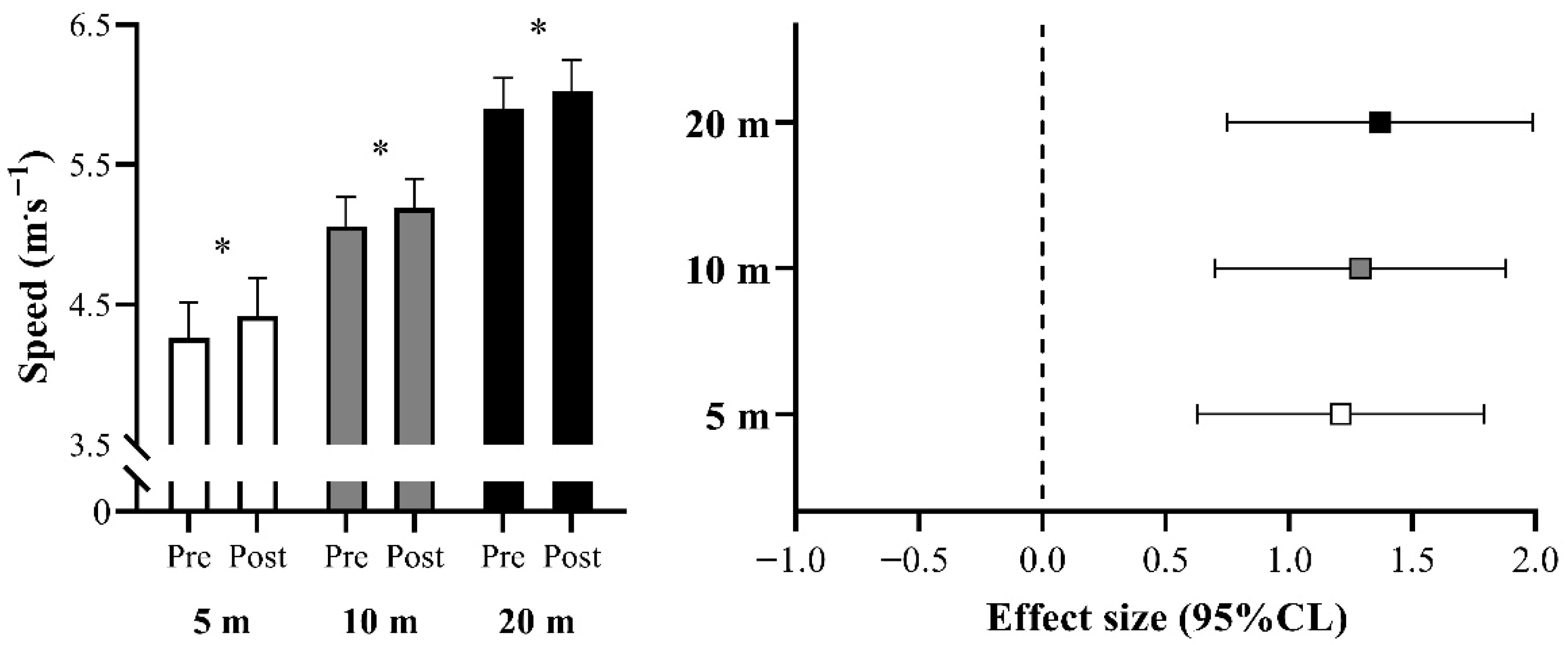Effects of a Short-Term Ballistic Training Program on Performance and Strength Deficit in Elite Youth Female Soccer Players
Abstract
1. Introduction
2. Materials and Methods
2.1. Subjects
2.2. Study Design
2.3. Procedures
2.3.1. Jump Performance Assessments
2.3.2. Sprint Speed Testing
2.3.3. One-Repetition Maximum in Half-Squat Exercise
2.3.4. Bar-Derived Variables and SDef in the Jump Squat Exercise
2.4. Statistical Analysis
3. Results
4. Discussion
5. Conclusions
Supplementary Materials
Author Contributions
Funding
Institutional Review Board Statement
Informed Consent Statement
Data Availability Statement
Conflicts of Interest
References
- McGuigan, M.R.; Wright, G.A.; Fleck, S.J. Strength training for athletes: Does it really help sports performance? Int. J. Sports Physiol. Perform. 2012, 7, 2–5. [Google Scholar] [CrossRef] [PubMed]
- Suarez-Arrones, L.; Gonzalo-Skok, O.; Carrasquilla, I.; Asián-Clemente, J.; Santalla, A.; Lara-Lopez, P.; Núñez, F.J. Relationships between change of direction, sprint, jump, and squat power performance. Sports 2020, 8, 38. [Google Scholar] [CrossRef] [PubMed]
- Suchomel, T.J.; Nimphius, S.; Stone, M.H. The importance of muscular strength in athletic performance. Sports Med. 2016, 46, 1419–1449. [Google Scholar] [CrossRef] [PubMed]
- González-Badillo, J.J.; Sánchez-Medina, L.; Pareja-Blanco, F.; Rodríguez-Rosell, D. La velocidad de ejecución y el deficit de fuerza. In Fundamentals of Velocity-Based Resistance Training; Ergotech: Murcia, Spain, 2017; pp. 109–114. [Google Scholar]
- Loturco, I.; Pereira, L.A.; Freitas, T.T.; Bishop, C.; Pareja-Blanco, F.; McGuigan, M.R. Maximum strength, relative strength, and strength deficit: Relationships with performance and differences between elite sprinters and professional rugby union players. Int. J. Sports Physiol. Perform. 2021, 16, 1148–1153. [Google Scholar] [CrossRef]
- Loturco, I.; Pereira, L.A.; Bishop, C.; Zanetti, V.; Freitas, T.T.; Pareja-Blanco, F. Effects of a resistance training intervention on the strength-deficit of elite young soccer players. Biol. Sport. 2022, 39, 615–619. [Google Scholar] [CrossRef]
- Carling, C. Interpreting physical performance in professional soccer match-play: Should we be more pragmatic in our approach? Sports Med. 2013, 43, 655–663. [Google Scholar] [CrossRef]
- Faude, O.; Koch, T.; Meyer, T. Straight sprinting is the most frequent action in goal situations in professional football. J. Sports Sci. 2012, 30, 625–631. [Google Scholar] [CrossRef]
- McKay, A.K.A.; Stellingwerff, T.; Smith, E.S.; Martin, D.T.; Mujika, I.; Goosey-Tolfrey, V.L.; Sheppard, J.; Burke, L.M. Defining training and performance caliber: A participant classification framework. Int. J. Sports Physiol. Perform. 2022, 17, 317–331. [Google Scholar] [CrossRef]
- Newton, R.U.; Kraemer, W.J.; Häkkinen, K. Effects of ballistic training on preseason preparation of elite volleyball players. Med. Sci. Sports Exerc. 1999, 31, 323–330. [Google Scholar] [CrossRef]
- Loturco, I.; Alcaraz, P.E.; Oliveira, L.P.; Tavares, L.D.; Requena, B.; Freitas, T.T.; Pereira, L.A. Challenges in speed and power development across age categories: A comparative study of female and male football players. Biol. Sport. 2025, 42, 3–9. [Google Scholar] [CrossRef]
- Cormie, P.; McGuigan, M.R.; Newton, R.U. Developing maximal neuromuscular power: Part 2—Training considerations for improving maximal power production. Sports Med. 2011, 41, 125–146. [Google Scholar] [CrossRef]
- McBride, J.M.; Triplett-McBride, T.; Davie, A.; Newton, R.U. The effect of heavy- vs. Light-load jump squats on the development of strength, power, and speed. J. Strength Cond. Res. 2002, 16, 75–82. [Google Scholar] [PubMed]
- Rossetti, M.L.; Munford, S.N.; Snyder, B.W.; Davis, S.E.; Moir, G.L. The effects of multiple sets of squats and jump squats on mechanical variables. J. Strength Cond. Res. 2020, 34, 1017–1023. [Google Scholar] [CrossRef] [PubMed]
- Loturco, I.; Pereira, L.A.; Kobal, R.; Zanetti, V.; Gil, S.; Kitamura, K.; Abad, C.C.; Nakamura, F.Y. Half-squat or jump squat training under optimum power load conditions to counteract power and speed decrements in brazilian elite soccer players during the preseason. J. Sports Sci. 2015, 33, 1283–1292. [Google Scholar] [CrossRef] [PubMed]
- Ugrinowitsch, C.; Tricoli, V.; Rodacki, A.L.; Batista, M.; Ricard, M.D. Influence of training background on jumping height. J. Strength Cond. Res. 2007, 21, 848–852. [Google Scholar]
- Brown, L.E.; Weir, J.P. Asep procedures recommendation i: Accurate assessment of muscular strength and power. J. Exerc. Physiol. Online 2001, 4, 1097–9751. [Google Scholar]
- Cohen, J. (Ed.) Some issues in power analysis: Effect size. In Statistical Power Analysis for the Behavioral Sciences, 2nd ed.; Lawrence Erlbaum Associates: Hillsdale, NJ, USA, 1988; pp. 531–535. [Google Scholar]
- Rhea, M.R. Determining the magnitude of treatment effects in strength training research through the use of the effect size. J. Strength Cond. Res. 2004, 18, 918–920. [Google Scholar]
- Los Arcos, A.; Yanci, J.; Mendiguchia, J.; Salinero, J.J.; Brughelli, M.; Castagna, C. Short-term training effects of vertically and horizontally oriented exercises on neuromuscular performance in professional soccer players. Int. J. Sports Physiol. Perform. 2014, 9, 480–488. [Google Scholar] [CrossRef]
- Meckel, Y.; Harel, U.; Michaely, Y.; Eliakim, A. Effects of a very short-term preseason training procedure on the fitness of soccer players. J. Sports Med. Phys. Fit. 2014, 54, 432–440. [Google Scholar]
- Taylor, J.; Portas, M.D.; Wright, M.D.; Hurst, C.; Weston, M. Within-season variation of fitness in elite youth female soccer players. J. Athl. Enhanc. 2013, 1, 1–5. [Google Scholar] [CrossRef]
- Freitas, T.T.; Pereira, L.A.; Reis, V.P.; Fernandes, V.; Alcaraz, P.E.; Azevedo, P.; Loturco, I. Effects of a congested fixture period on speed and power performance of elite young soccer players. Int. J. Sports Physiol. Perform. 2021, 16, 1120–1126. [Google Scholar] [CrossRef] [PubMed]
- Barra-Moura, H.; Guilherme Vieira, J.; Zacaron Werneck, F.; Wilk, M.; Pascoalini, B.; Queiros, V.; Gomes de Assis, G.; Bichowska-Paweska, M.; Vianna, J.; Vilaca-Alves, J. The effect of complex contrast training with different training frequency on the physical performance of youth soccer players: A randomized study. PeerJ 2024, 12, e17103. [Google Scholar] [CrossRef] [PubMed]
- Thomakos, P.; Spyrou, K.; Katsikas, C.; Geladas, N.D.; Bogdanis, G.C. Effects of concurrent high-intensity and strength training on muscle power and aerobic performance in young soccer players during the pre-season. Sports 2023, 11, 59. [Google Scholar] [CrossRef] [PubMed]
- Molina, R.; Lapresa, D.; Arana, J.; Alvarez, I.; Salazar, H. Wellness and session rating of perceived exertion in professional basketball players within different weekly contexts. J. Strength Cond. Res. 2025, 39, e546–e551. [Google Scholar]
- Carron, M.A.; Scanlan, A.T.; Doering, T.M. Quantifying the training loads and corresponding changes in physical qualities among adolescent, schoolboy rugby league players. Sports 2024, 12, 251. [Google Scholar] [CrossRef]
- Purdom, T.M.; Levers, K.S.; Ryan, G.A.; Brown, L.; Giles, J.; McPherson, C. Female soccer periodization on anaerobic power/capacity. J. Strength Cond. Res. 2023, 37, 2405–2410. [Google Scholar] [CrossRef]
- Oliveira, R.S.; Leicht, A.S.; Bishop, D.; Barbero-Álvarez, J.C.; Nakamura, F.Y. Seasonal changes in physical performance and heart rate variability in high level futsal players. Int. J. Sports. Med. 2013, 34, 424–430. [Google Scholar] [CrossRef]


| Monday | Tuesday | Wednesday | Thursday | Friday | Saturday | Sunday | |
|---|---|---|---|---|---|---|---|
| Morning | Rest | Speed warm-up (technical drills followed by 4–6× maximal short sprints of 10–15 m) Technical training | Small-sided games # | Speed warm-up (technical drills followed by 4–6× maximal short sprints of 10–15 m) Technical training | Small-sided games # | Technical training | Friendly matches ¥ |
| Afternoon | * Ballistic training | * Ballistic training | Unloaded jump training + | * Ballistic training | Unloaded jump training + | Rest | Rest |
| Pre | Post | p-Value | ES (95% CL) | |
|---|---|---|---|---|
| JS PV at 30% 1RM (m·s−1) | 1.96 ± 0.12 | 2.03 ± 0.13 | <0.001 | 1.28 (0.69; 1.86) |
| JS PF at 30% 1RM (N·kg−1) | 7.09 ± 0.51 | 7.42 ± 0.61 | 0.014 | 0.57 (0.12; 1.02) |
| JS PP at 30% 1RM (W·kg−1) | 11.9 ± 1.4 | 12.9 ± 1.6 | <0.001 | 0.90 (0.40; 1.39) |
| 1RM rel | 1.23 ± 0.13 | 1.39 ± 0.17 | 0.032 | 0.49 (0.04; 0.93) |
| PF at 1RM (N·kg−1) | 47.8 ± 11.2 | 49.5 ± 11.2 | 0.076 | 0.40 (−0.04; 0.83) |
| SDef at 30% 1RM (%) | 83.9 ± 6.3 | 83.9 ± 5.9 | 0.442 | 0.17 (−0.26; 0.59) |
Disclaimer/Publisher’s Note: The statements, opinions and data contained in all publications are solely those of the individual author(s) and contributor(s) and not of MDPI and/or the editor(s). MDPI and/or the editor(s) disclaim responsibility for any injury to people or property resulting from any ideas, methods, instructions or products referred to in the content. |
© 2025 by the authors. Licensee MDPI, Basel, Switzerland. This article is an open access article distributed under the terms and conditions of the Creative Commons Attribution (CC BY) license (https://creativecommons.org/licenses/by/4.0/).
Share and Cite
Loturco, I.; Requena, B.; Mercer, V.P.; Moura, T.B.M.A.; Alexandre, M.G.A.; Tavares, L.D.; Pereira, L.A. Effects of a Short-Term Ballistic Training Program on Performance and Strength Deficit in Elite Youth Female Soccer Players. Sports 2025, 13, 237. https://doi.org/10.3390/sports13070237
Loturco I, Requena B, Mercer VP, Moura TBMA, Alexandre MGA, Tavares LD, Pereira LA. Effects of a Short-Term Ballistic Training Program on Performance and Strength Deficit in Elite Youth Female Soccer Players. Sports. 2025; 13(7):237. https://doi.org/10.3390/sports13070237
Chicago/Turabian StyleLoturco, Irineu, Bernardo Requena, Valter P. Mercer, Tulio B. M. A. Moura, Matheus G. A. Alexandre, Lucas D. Tavares, and Lucas A. Pereira. 2025. "Effects of a Short-Term Ballistic Training Program on Performance and Strength Deficit in Elite Youth Female Soccer Players" Sports 13, no. 7: 237. https://doi.org/10.3390/sports13070237
APA StyleLoturco, I., Requena, B., Mercer, V. P., Moura, T. B. M. A., Alexandre, M. G. A., Tavares, L. D., & Pereira, L. A. (2025). Effects of a Short-Term Ballistic Training Program on Performance and Strength Deficit in Elite Youth Female Soccer Players. Sports, 13(7), 237. https://doi.org/10.3390/sports13070237







